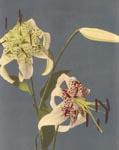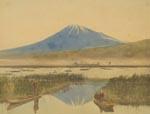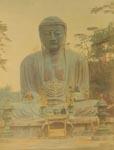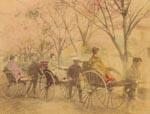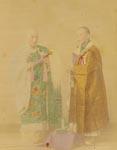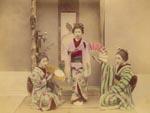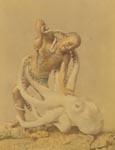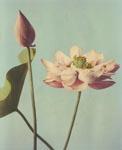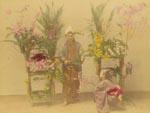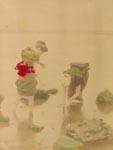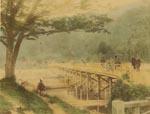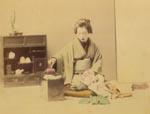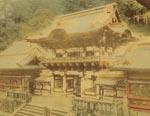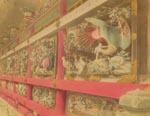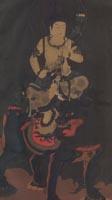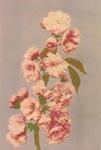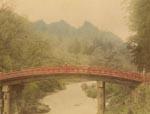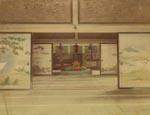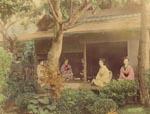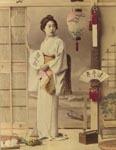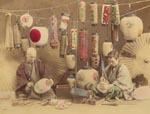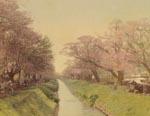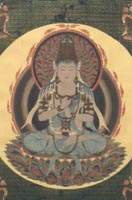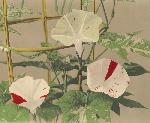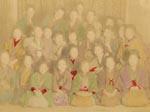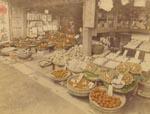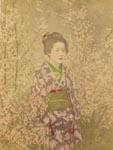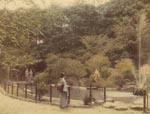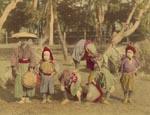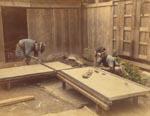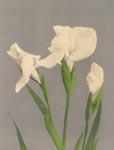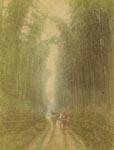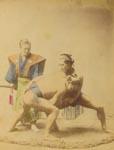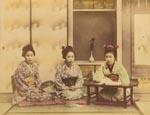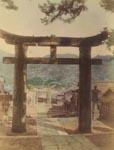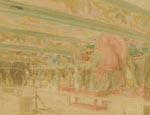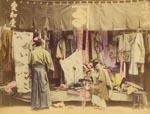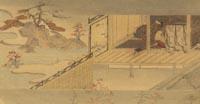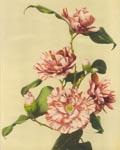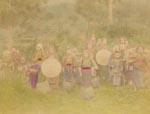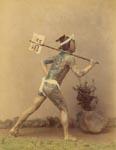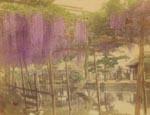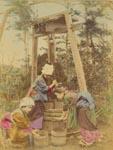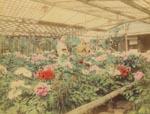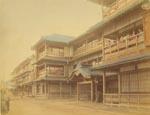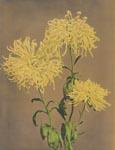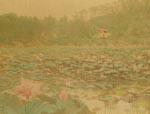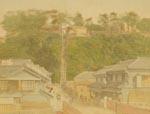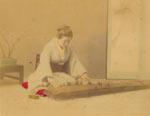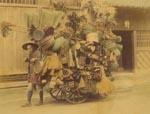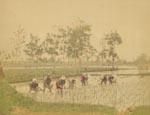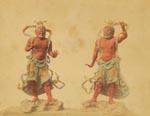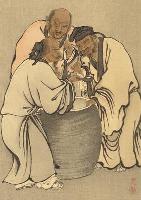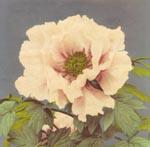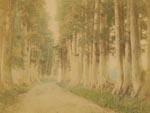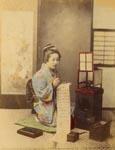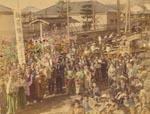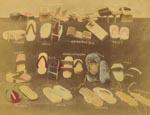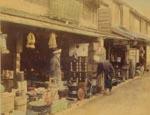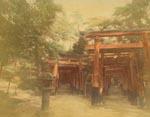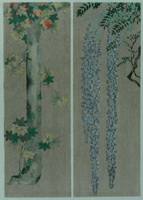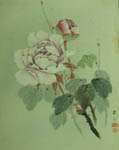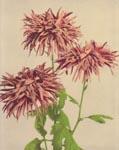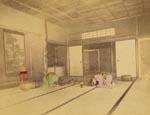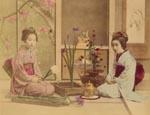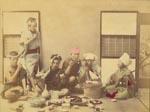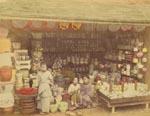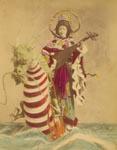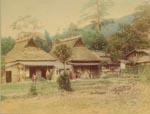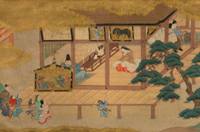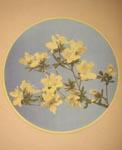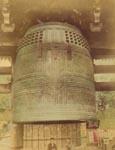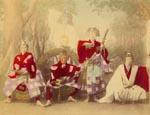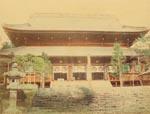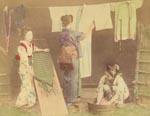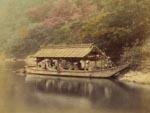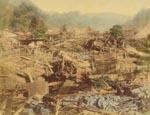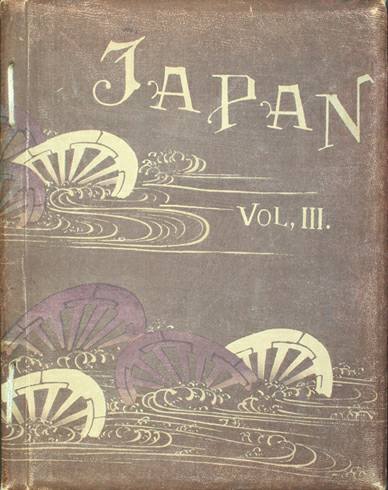
Okakura, Kakuzo
Brinkley, Frank (Captain):
Japan, Described and Illustrated by the Japanese, Written By Eminent Japanese Authorities and Scholars, Boston & Tokyo, J.B. Millet Company, 1897~8, 10 volume set designated "Edition De Luxe" limited to 750 numbered copies, folio (12 1/2 x 15+ in), silk covers with beveled edges, 10 color flower collotypes by Kazumasa Ogawa, 60 hand colored albumen photographs, 10 color art reproduction plates (one at the rear of each volume), numerous hand colored albumen text illustrations/photographs (200), 462 pp (382 pages of text with 200 text illustrations + 80 full plates). The books are organized into specific topics, covering Japanese festivals, history, customs, medieval Japan etc. Each book has a narrative text, a color flower collotype by Kazumasa Ogawa, six (6) 8 x 10 1/2 inch hand colored albumen photographs, hand colored albumen photograph text illustrations (ca 20) and a color art reproduction plate with accompanying essay by Kakuzo Okakura. This set is renowned for its superb visual content.
The collotype flower plates are printed on the plate. The albumen photographs are tipped to plate. Both collotypes and albumen photographs are mounted with covering mats. The plates and mats are in matching colors. The mats are affixed (glued) to the plates at the binding edge and also glued approximately 1/4 the distance along the two adjacent edges. An example of this is shown below.
The text illustrations in the deluxe edition differ are different images from those found in the standard/regular editions. Further, they are tipped in hand colored albumen photographs as opposed to the black and white half tone images in the regular/standard sets. A copy of a page with a tipped in color albumen photograph text illustration is shown below.
An image of the edition page is here.
The work is a guide to the Japanese and 19th Century Japan in general. It is a very complete introspective view to that culture before the results of Western influence were manifest. Considered by many to be one of the finest primary visual sources on Japan before her leap towards modernization, this set is a superb photographic essay and statement of what Japan looked before modernization. It is a broad and wonderful view of travel in the main and obscure places, daily activities and photos of people engaged in the toil of trades, farming, commence and household activities. Truly a complete view to the Japanese with essays by their scholars in English.
Technically speaking, these books are often classified as an "19th Century American Color Illustrated" books. While the collotypes, hand colored albumen photographs and color art reproduction plates were imported from Japan, the books were printed, assembled and distributed in the United States. In the introduction no individual is credited with providing the photographs. It merely notes they "... are made and colored by hand in Japan, over three hundred and fifty native artists having been specially engaged for this purpose."
Wenckstern does not state the new issue price of the deluxe edition set. However, he quotes the issue price for the regular/standard 10 volume set as $40. I suspect the deluxe edition sets were double to triple the regular edition price.
Francis Brinkley (1841 - 1912 Tokyo), an Englishman and Japanophile originally came to Japan in 1867 as gunnery instructor. He later went into English education and journalism. Okakura Tenshin, who was the principal of Tokyo Art School (the present Tokyo National University of Fine Arts and Music), also contributed to this set.
Each volume begins with a full-page classic color collotype plate of a flower by the famous Japanese photographer Kazumasa Ogawa.
Example of Ogawa Flower Photograph
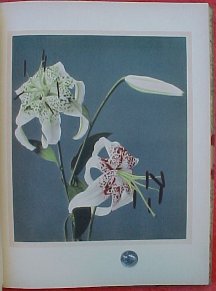
Covers are decorated colored brocade cloth with beveled edges and tied with thick cord stitching which firmly binds the contents in traditional Japanese manner. The introduction states the covers were printed in Tokyo by the Xylograph process under the supervision of K. Ogawa. The silk tassels and cords were provided by S. Iida of Kyoto.
The title page indicates "With An Essay on Japanese Art by Kakuzo Okakura" which is not found in the regular editions.
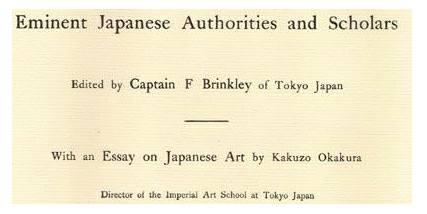
Complete Title Page here.
At the back of each volume is the essay by Kakuzo (aka Tenshin) Okakura and a color reproduction of a famous Japanese painting. The introduction in Volume 1 states:
The Xylograph prints illustrating the lecture on Japanese art by K. Okakura, Director of the Imperial Art Academy, are printed in Tokyo by the Kokkwa Publishing Company.
Kakuzo (aka Tenshin) Okakura was also associated with the Kokka and I believe that is the same company that is referred to as the Kokkwa Publishing Company.
This is an example from Volume VII.
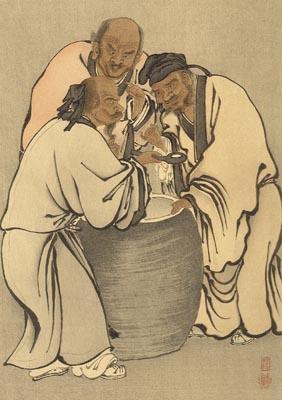
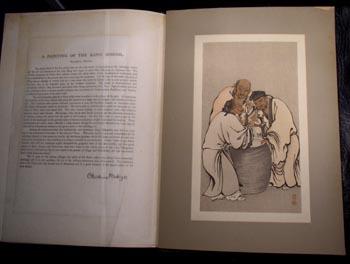
Composite Listing Flower Collotypes
and Albumen Photos
Table of contents of each volume, plus a listing of the photographs.
Legend:
- These plates are in both the standard and deluxe set editions.
- These plates are only in the deluxe set editions.
A web page with only the plates found in deluxe and standard editions is here.
Volume I. (pages 1~34)
Volume II. (pages 35~74)
Volume III. (pages 75~112)
Volume IV. (pages 113~152)
Volume V. (pages 153~190)
Volume VI. (pages 191~230)
Volume VII. Festivals. (pages 231~268)
Volume VIII. (pages 269~308)
Volume IX. (pages 309~346)
Volume X. (pages 347~382)
|
Chapters (Total of 15)
- The Empire; its Size, Buildings, Cities and Scenery.
- The Early Japanese and Their History.
The Early Japanese and Their History (Concluded).
- The Story of the Forty-seven Ronins.
- Establishment of the Tokugawa Dynasty, and Japan's Relations with the Orient in the Early Ages of the Christian Era.
- Japan's Debt to Continental Neighbors in Early Eras
- Mediaeval Japan.
- Yoshitsune, Genghis and the Mongol Invasion.
Yoshitsune, Genghis and the Mongol Invasion (Concluded).
- Creed and Castes.
- Religion and Rites.
- Superstitions and Divination.
- Festivals.
- Observances and Pastimes.
Observances and Pastimes (Concluded).
- Japan's Commercial and Political Intercourse with Foreign Countries.
Japan's Commercial and Political Intercourse with Foreign Countries (Concluded).
- The Attitude of Japan Toward Foreign Residents. Japanese Finance.
The Attitude of Japan Toward Foreign Residents. Japanese Finance (Concluded).
- Modern Japan in Brief.
Matting of Full Page Plates. The collotype plates are printed on the plate. The albumen photographs are tipped to plate. Both collotypes and albumen photographs are mounted with covering mats. The plates and mats are in matching colors. The mats are affixed (glued) to the plates at the binding edge and also glued approximately 1/4 the distance along the two adjacent edges.
An Example of the Matted Plates, Deluxe Edition
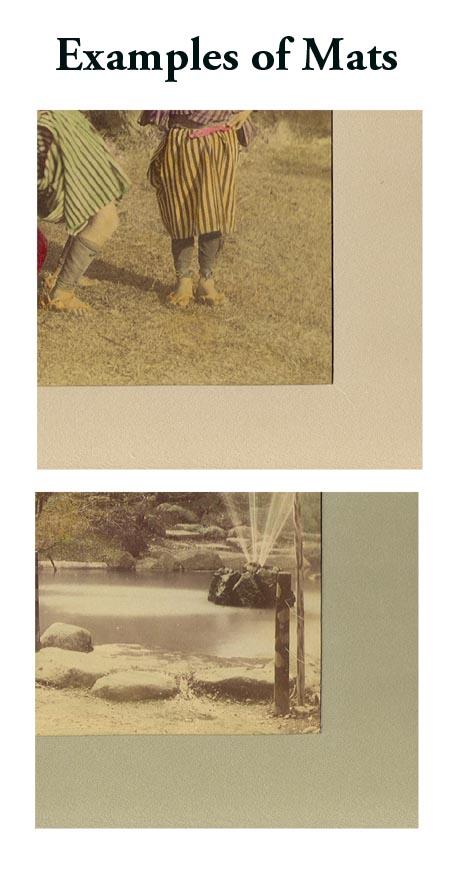
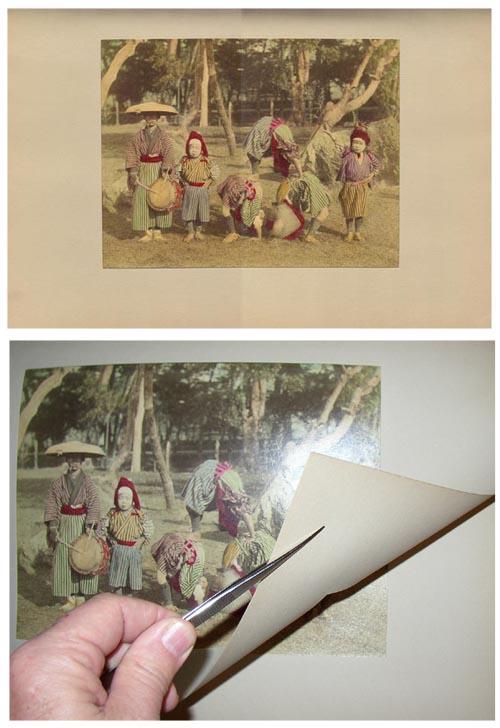
An Example of a Tipped in Hand Colored
Albumen Photograph Text Illustration
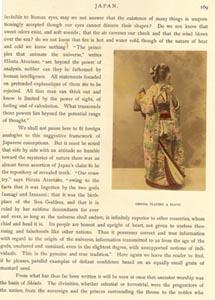
General Comments Regarding the Brinkley Book Sets.
- Regular and Deluxe Formats. The set was issued in two basic formats described below.
Regular/standard format editions normally have 10 volumes containing 10 Kazumasa Ogawa color collotypes of flowers (frontispiece to each volume) and 30 hand colored albumen photographs tipped to plate (3 per volume). They also have 200+ text illustrations which are half-tone black and white and printed directly on the page. The set was also issued as a 15 section series with decorative card wraps. This is a variant of the standard 10 volume set. It does contain 5 more Ogawa color collotypes of flowers and lithographic replicas of the silk screens.
Deluxe format editions of this series contain the same 10 Ogawa color collotypes of flowers (frontispiece to each volume) and 60 hand colored plates (6 per volume - image 8 x 10 inch generally). Thirty of the plates are identical to those found in the 10 volume series and 30 are different. In addition, the text illustrations (image 3 1/2 x 5 in) in the deluxe format volumes, of which there are 200, are also hand colored tipped in albumen photographs with captions printed on the page directly below the illustration. The collotypes and albumen photographs plates are mounted on colored paper and have a colored mat affixed to the page. The deluxe editions also have 10 color/xylograph plates reproducing Japanese Paintings and some editions contain 10 (20) color plates with actual Japanese art work (ie paintings on silk, watercolors, color woodblocks, mono-color stencil prints on silk as used in printing fabrics).
- Various Editions/Number of Sets Produced. There were numerous editions of both standard and deluxe format editions. Those I am aware of can be found listed here. I have accounted for 1,425 deluxe/limited edition book sets (12 different editions) and there probably were more. For standard or regular editions I have accounted for 3,075+ sets across 4 different edition. Further there is no quantity stated for the 15 section set.
Sebastian Dobson in Art & Artifice, Japanese Photographs of the Meiji Era, states:
During the years of 1897 and 1898, the work was published in various limited editions, and for fourteen of the sixteen editions produced we know that 151,500 large-format photographs and 254,000 small-format photographs were hand-colored and later tipped into 37,750 individual volumes. (at page 33-34) (Author's footnote refers to Denise Bethel, "The J.B. Millet Company's Japan: Described and Illustrated by the Japanese," Image, volume 34, numbers 1-2 (1991): 3-32)
Since the small-format photographs were only placed in deluxe edition sets and each set would have 200 of them, that would mean 1,270 sets of deluxe editions with 10 volumes each (245,000/200). This is relatively close to my accounting of 1,425 sets. Using the Bethel number of total large plates (151,500), I calculate a total of 2,510 standard editions (151,500-85,500 [large plates in deluxe editions = 60 per set x 1,425 sets = 85,500] = 66,000/30 [30 large plates in regular editions] = 2,200 sets of standard/regular editions). I have accounted for 3,075 sets, a third more than the quoted number 151,500 would support. The figure of large format plates was probably more like 175,000 - 200,000.
- Covers/Bindings. In the 10 volume sets the cover are decorative cloth (linen) over heavy boards. Each volume in a set has matching decorative patterns but different color schemes. The standard edition sets have pasted on titles while the deluxe edition sets have the title printed on the cloth. All 10 volume sets have cord ties. The cord ties are decorative only and not essential for holding the books together. Internally, the pages are firmly bound together at the inside margins with staples, string and glue. The covers on the 15 section set are decorative card stock with the same logo and color.
- Source of Color Albumen Photographs. Terry Bennett, in his book Early Japanese Images, identifies Kozaburo Tamamura as the source of the colored albumen photographs used in these book sets. He states that Tamamura provided 180,000 photographs to a dealer in Boston which were "undoubtedly" provided for the Brinkley books (see page 52). Tamamura was a famous photographer and serviced the tourist souvenir photograph trade in Japan as well as the export trade. It is clear that many of the photographs supplied were from his inventory. However, it is also clear that he used photographs taken by other famous Japanese photographers. Many of the albumen photographs were from Kazumasa Ogawa, who also provided the color flower collotypes for the books. Notice the similarity between the Brinkley color albumen photograph titled "A Tokyo Beauty" (Volume III, "De luxe" Edition) and a K. Ogawa collotype from Celebrated Geysha of Tokyo published ca 1892. For more information on the Geysha book, click here.
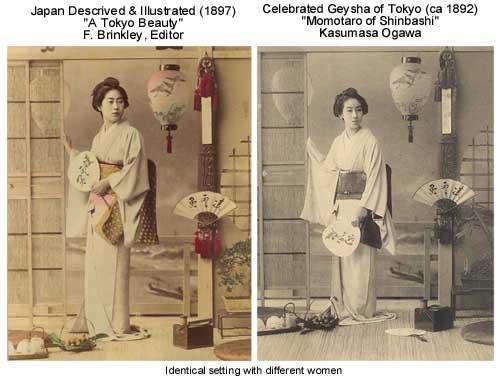
The problem with attributing the photographs to a particular photographer is the lack of credits on the photographs or in the books.
- Text Illustrations. The text illustrations in the standard format editions (black and white halftone printed directly on the page) and those in the deluxe edition formats (tipped in colored albumen photographs) are not the same. Basically, a different set of the 200+ in text illustrations was used in the two formats. Since neither set of text illustrations actually depicted the associated text, it really does seem to matter. It my opinion, they were pretty much added at random to enhance the visual appearance of the books.
- American Color Illustrated Book. Technically speaking, these books are often classified as an "19th century American color illustrated" books. While the collotypes and hand colored albumen photographs were imported from Japan, the books were printed, assembled and distributed in the United States.
- Illustrated Discussions of Various Sets on this site.
- 10 Volume "Edition De Luxe" deluxe type edition is here.
- 10 Volume "Yedo" standard type edition is here.
- 15 Section card stock cover set is here.
- Composite view of full page collotypes and albumen photographs in the standard and deluxe sets here.
- Individual K. Ogawa color flower collotypes marketed by Millet Co. here.
- Related Pictorial Arts Set Published in 1901/2.
- The Art of Japan, Pictorial Art, Volume 1, Deluxe Edition here.
Covers from Other Editions
Cover from the 1897 - 15 Section (Paper Wraps) Set
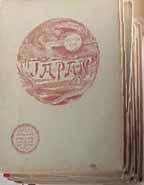
Covers from the 1897 - 10 Volume - Memorial Edition
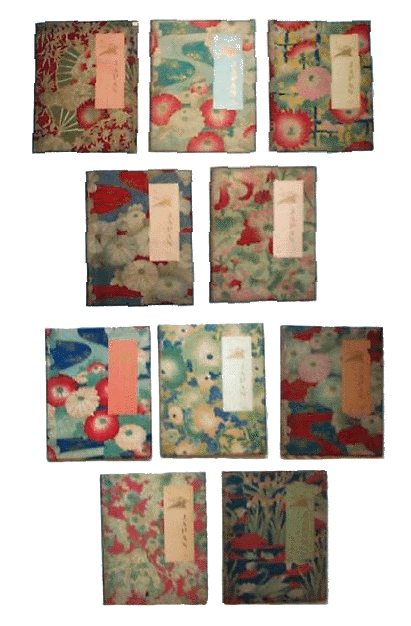
The following publishers note has been recorded with a deluxe type edition which was composed of the 15 section set with supplemental plates.
This set comprises 15 sections bound in ten books of unique and elaborate design. The ten books are fitted into five fancy boxes. Each section contains about 26 pages of text, 4 full page plates and approximately 13 text illustrations. Over 350 artists were employed in hand painting the photographs illustrating life in Japan, for this special edition and also for the regular edition.
There are 15 collotypes [A collotype is a a kind of photo-lithograph in which glass replaces stone as the printing surface] of Japanese flowers produced by a process that could not be duplicated outside Japan. The colors used and mounting methods are most impressive. 15 to 25 colors were used in a single picture and each print passed through a press for each shade.
The front of each book has a mounted and faithful reproduction of an important piece of art. The last section of each book provides yet another important art reproduction along with a critique by the most renowned art critics of the time.
In entirety, the set contains 30 full page Japanese photographs (8x10) colored by hand, 15 full page colored plates, 15 full page decorative designs, and 200 text illustrations.
A glimpse of life in Japan before the turn of the century may be viewed through these books. Pages unravel a brief history of Japan; its relationships and attitudes towards eastern and western nations as well as religious practices, rites, and observances, festivities, and pastime activities.
The text, photographs, plates, and illustrations were written and prepared for the most part by Japanese experts. When the subjects required an intimate aquaintance with western cultures, American and European writers were called upon to supply information. The editor lived in Japan 30 years prior to publication.
|







